TOM FERNANDEZ — JUNE 1, 2014
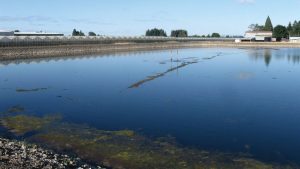
Competition for diminishing water supplies is heating up, challenging growers to secure reliable sources. Implementing quality control measures now will help to ensure continued growth.
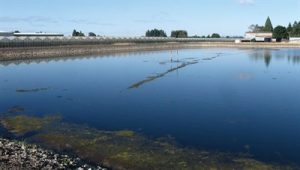
Click image to enlarge.
At a large nursery and greenhouse operation in Oregon, a reservoir is maintained to capture and recycle irrigation water.
Photo courtesy of Tom Fernandez.
Water is rapidly becoming one of the biggest production challenges for the ornamental plant industries. Ten years ago I would have discussed water quality in relation to the chemical and biological properties that were likely to be encountered in irrigation water, such as alkalinity, soluble salts and aquatic organisms affecting irrigation systems. Plenty of good information exists about managing these problems. But with the increased use of and competition for water resources, the water quality issues of the future are going to result from how water resources are used and managed by the industry and other use groups.
The availability and quality of water have always been significant considerations when selecting or expanding sites for nursery and greenhouse operations. As populations grow and urbanization continues, communities withdraw more water from current water resources. Agricultural and industrial water use is also expanding. In other words, more people are drinking from the same cup. Those resources are not growing, so the water in the cup is dropping. At the same time, higher quality water sources are being set aside for direct human use. This drives nursery and greenhouse operations to locate farther from urban centers, improve water use efficiency, and/or use alternative—sometimes lower—quality water sources for irrigation. The competition for water among use groups only will become stronger, and water issues should be a greater concern in site selection.
The right source
Surface water sources (rivers and lakes) often have good chemical characteristics but, depending on upstream or adjacent users, can have many of the same problems as recycled water. The difficulty with poor quality surface water sources is that improving them is much like improving recycled water. We’ll discuss this a bit later.
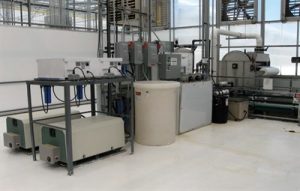
Click image to enlarge.
Modern irrigation treatment systems can be quite complex. Water is mechanically filtered and chemically treated at this large greenhouse operation in Michigan.
Photos on this page courtesy of Tom Fernandez
Aquifer systems are typically composed of more than one aquifer occurring in vertical layers, each having different water quality characteristics. Higher water extraction due to competition can lead to the need for deeper wells that draw from lower aquifers. Drilling into another aquifer can result in different water quality, since water quality is affected by the surrounding formations. For example, moving from relatively shallow sand/gravel surficial aquifers into limestone aquifers can result in alkalinity problems. Choosing sites with good water quality in several and deeper aquifers will improve future options for growers.
Some water use and management practices can result in the development or aggravation of familiar issues. Soluble salts are a common problem in several areas of the country and management techniques, such as proper leaching and fertilizing, are well understood. However, the soluble salt problem is expanding. Growers who in the past did not need to worry about soluble salt issues are starting to experience them. Seacoast areas are familiar with the problem of saltwater intrusion from the sea into aquifers. Seacoasts are among the main areas where competition is highest for water resources. As more user groups extract more water, saltwater intrusion becomes more widespread and farther inland along coastal areas.
This is no longer just a seacoast problem, however; saltwater intrusion problems have been reported in 22 inland states (there are 23 states with a seacoast). Salt water is denser than fresh water and settles toward the bottom portions of aquifers associated with former seas or areas with naturally high salt deposits. These aquifers occur throughout a large part of the U.S. In some such aquifers with limited aquifer recharge and/or high water extraction, water high in salts from deeper regions of the aquifer are being drawn upward to the zone of pump extraction and entering irrigation systems. Runoff from irrigation pumped from aquifers with high soluble salts can enter surface water resources, so irrigators using surface water are not necessarily immune from this issue. However, it is rare that surface waters are significantly degraded in this manner.
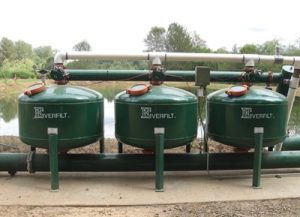
Click image to enlarge.
Fertilizer and chlorine can be injected into irrigation water through these controls; sand filters also treat recaptured irrigation water before it is reentered into the irrigation system.
Capture and recycle
One solution to the competition for water resources is to recycle irrigation water and capture rainwater. This results in more efficient use of the original water resource, thus extending its irrigation capacity. Land has to be graded and reservoirs developed to accomplish this, so it is easiest to do for new operations. But existing operations can be redesigned, as well.
In most areas of the country, where air pollution is minimal, rainwater quality is very good.
Rainwater that falls directly into reservoirs or has minimal contact with production areas is likely to improve water quality. Irrigation water from the original source will often carry any original water quality issues with it into the reservoir. Rainwater and irrigation water that comes into contact with the production area can carry contaminants such as nutrients, pesticides and plant pests into reservoirs. Therefore, appropriate treatment and handling of water as it enters reservoirs and before reirrigating is necessary, including preentry treatments, reservoir size and depth, and irrigation intake location.
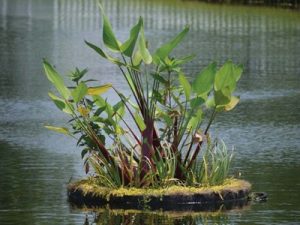
Click image to enlarge.
An ornamental floating treatment wetland can be used in aquatic landscapes after filtering recycled water.
Photo courtesy of Dr. Sarah White, Clemson University
Because capturing and recycling water both positively and negatively affects irrigation water quality, the development of reservoirs results in a new water source with different water quality than the original sources. This can provide irrigation managers with options for irrigating crops from the original water source, the reservoir, or a blend from both sources based on plant tolerance to water quality parameters and pests.
Soils and container substrates can only retain a certain amount of nutrients. Overirrigation will leach nutrients from containers or deeper into the soil profile, potentially entering water resources. One of the benefits of recycled irrigation water is the recycling of leached nutrients. Recycled nutrients can increase soluble salt levels, so the fertilization program should be modified to avoid excess soluble salt buildup by accounting for reapplication of nutrients.
Pesticides end up being recycled, too, and can have positive and negative consequences. It is possible that reapplication of pesticides can extend control of pests, although research is sparse in this area. Conversely, pesticides can result in a phytotoxic response, especially in sensitive plants. Herbicides are not the only pesticide of concern, and many herbicides are of minor concern since they often do not dissolve easily in water and bind quickly and strongly to soils, organic matter and other elements in the production environment. However, herbicides can be moved on sediments or particles of these materials and can build up in reservoirs if sediment movement is not managed.
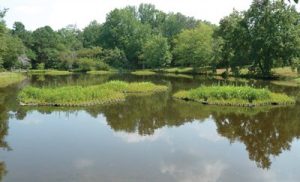
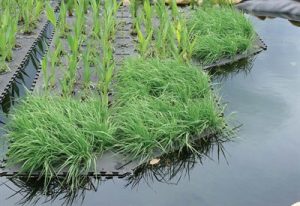
Click image to enlarge.
The root systems extend into the water from these floating treatment wetlands to filter out nutrients and other contaminants. Plants can be removed from this floating treatment wetland and sold.
Photos courtesy of Dr. Sarah White, Clemson University
Pesticides with high water solubility and low binding potential that cause phytotoxic responses in plants are more of a concern in recycled water. There are fungicides and insecticides that can cause phytotoxicity. In either case, phytotoxicity is usually limited to sensitive plants, with the majority of nursery stock not being harmed. Still, growers should be aware of the potential for a phytotoxic response and make sure that sensitive plants are irrigated with non-recycled water or appropriate treatments are used to mitigate pesticide levels.
Pathogens and other plant pests can be an issue when using recycled water. In addition to disinfestation treatments, which may not be economical for large irrigation volumes, proper reservoir design and siting and depth of pump inlets can reduce inocula spread through irrigation. Site pump inlets as far away from runoff inflows as possible to allow dilution and sedimentation to occur. Many pests will settle or distribute below pump inlets if enough distance can be provided. Inlets should be at least 2 feet below the water surface to reduce air and surface water intake by vortex creation and high enough from the reservoir bottom to avoid disturbance and intake of sediments.
Sanitation, especially near waterways and reservoirs, will help reduce the introduction of inocula into recycled water. Keeping contaminated plant parts, substrates and soils from entering or contacting the water system will substantially reduce pest spread. Also avoid placing plants that are susceptible to waterborne pests near waterways and reservoirs. It must be remembered that the presence of inocula does not mean that infection will occur. Often improper irrigation practices can cause the opportunity for infection.
In addition to reducing the opportunities for pest infection, improving irrigation management will also improve water quality. Improving irrigation distribution uniformity, grouping plants in irrigation zones based on similar water needs, and irrigating based on plant requirements will reduce over- or underirrigation within irrigation zones. These practices also will reduce the amount of nutrients and pesticides moving in runoff water while retaining nutrients and pesticides where they are needed.
We have been irrigating in our outdoor research nursery in Michigan at a leaching fraction of zero for eight years. We have found anywhere from a 30- to 75-percent reduction in the amount of irrigation applied with a similar reduction in runoff volume and lower amounts of nitrates and phosphates in runoff water. If the fertilizer program is modified to account for no or low leaching, salt buildup will be reduced. Rather than always applying irrigation to result in some leaching, a periodic leaching irrigation can be provided if soluble salts are building up. In outdoor production, rainfall, at least in the eastern U.S., often fulfills this function. In greenhouse or more arid production areas growers may need to provide a leaching irrigation event if salts are building up. This will require better monitoring of substrate soluble salts, but this can be done with the simple, rapid pour-through EC and pH procedure.
An ounce of prevention
Water quality can be substantially improved by treating it before it enters. Standard filtration systems can be used to remove sediments and some pests. Vegetated filter strips, vegetated waterways and constructed wetlands can reduce the amounts of nutrients, pesticides and pests in water before it enters recycling reservoirs or leaves operations. Because many of these contaminants move in water on sediments, much of the benefit from these filter systems results from slowing water movement to allow sedimentation to occur. The plants in these systems will take up excess nutrients and can cause or enhance degradation of pesticides through natural processes or bioremediation. Sedimentation ponds can be used to allow particles to settle out, but the other benefits are not as great. In either case the systems should be designed to allow for periodic removal of accumulated sediments or treatment areas will become ineffective.
In the case where chemical treatment is economical, reducing sediments in the water will make treatments more effective.
Floating treatment wetlands are relatively new and can be added to existing reservoirs. These are floating mats with plants growing in them. The roots extend into the water and filter out nutrients. They can also improve degradation of other contaminants in the water. One advantage of floating treatment wetlands is that the plants can be harvested relatively easily and introduced into production.
Finally, there are federal, state and local regulations regarding the extraction of water, runoff water quality, and capture and use of water, especially rainwater and surface water. Growers need to be aware of these regulations before installing wells, pumping stations, reservoirs or modifying drainage.
Water quality is a much more complicated issue than can be addressed in one article. Research continues to investigate methods to improve irrigation management and water quality. Watch these pages in the coming months for more information.
Dr. Tom Fernandez is Associate Professor in the Department of Horticulture, Michigan State University, specializing in water management and quality. He can be reached at [email protected].
Learning more
For more detailed information on ways to manage water quality, here are some of the many resources and references available.
Irrigation and plant pathogens webinars: http://www.irrigation-pathogens.ppws.vt.edu/webinar
BMP: http://contents.sna.org/bmpv30.html
Water, nutrients and plant health: http://www.waternut.org
Beeson, Jr., R.C., M.A. Arnold, T.E. Bilderback, B. Bolusky, S. Chandler, H.M. Gramling, J.D. Lea-Cox, J.R. Harris, P.J. Klinger, H.M. Mathers, J.M. Ruter, and T.H. Yeager. 2004. Strategic vision of container nursery irrigation in the next ten years. Journal of Environmental Horticulture 22:113-115.
Briggs, J.A., T. Whitwell, R.T. Fernandez and M.B. Riley. 2002. Effect of integrated pest management strategies on chlorothalonil, metalaxyl and thiophanate-methyl runoff at a container nursery. Journal of the American Society for Horticultural Science 127:1018-1024.
Fulcher, A. and R.T. Fernandez. 2013. Sustainable nursery irrigation management: Part 1. Water use in nursery production. Univ. TN CES W278, https://utextension.tennessee.edu/publications/Documents/W278.pdf
Fulcher, A. and R.T. Fernandez. 2013. Sustainable nursery irrigation management: Part 2. Strategies to increase efficiency. Univ. TN CES W 279, https://utextension.tennessee.edu/publications/Documents/W279.pdf
Fulcher, A. and R.T. Fernandez. 2013. Sustainable nursery irrigation management: Part 3. Strategies to manage nursery runoff. Univ. TN CES W280, https://utextension.tennessee.edu/publications/Documents/W280.pdf
Hong, C.X. and G.W. Moorman. 2005. Plant pathogens in irrigation water: Challenges and opportunities. Critical Reviews in Plant Sciences. 24:189-208.
Stewart-Wade, S.M. 2011. Plant pathogens in recycled irrigation water in commercial plant nurseries and green houses: their detection and management. Irrigation Science 29:267-297. Download at 10.1007/s00271-011-0285-1
Warsaw, A.L., R.T. Fernandez, D.R. Kort, C. Vandervoort, B.M. Cregg, and D.B. Rowe. 2012. Remediation of metalaxyl, trifluralin, and nitrates from nursery runoff using container-grown woody ornamentals. Ecological Engineering 47:254-263
Warsaw, A.L., R.T. Fernandez, B.M. Cregg and J.A. Andresen. 2009. Water conservation, growth, and water use efficiency of container-grown woody ornamentals irrigated based on daily water use. HortScience 44:1573-1580.
Warsaw, A.L., R.T. Fernandez, B.M. Cregg and J.A. Andresen. 2009. Container-grown ornamental plant growth and water runoff volume and nutrient content under four irrigation treatments. HortScience 44:1308-1318.
White, S.A., M.D. Taylor, R.F. Polomski, and J.P. Albano. 2011. Constructed wetlands: A how to guide for nurseries. FNRI USDA-ARS. HRI SCA #58-6618-7-216. http://www.hriresearch.org/Docs/HRI/Constructed%20Wetlands%20A%20How%20to%20Guide%20for%20Nurseries.pdf
White, S.A. 2013. Wetland technologies for nursery and greenhouse compliance with nutrient regulations. HortScience 48:1103-1108.